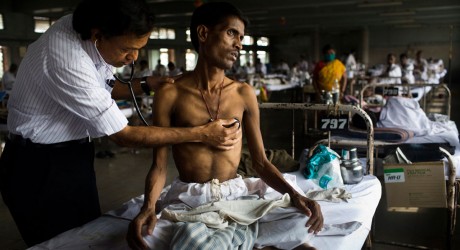By Caribbean Medical News Staff
GENEVA – The fight against tuberculosis is paying off, with this year’s death rate nearly half of what it was in 1990. Nevertheless, 1.5 million people died from TB in 2014. Most of these deaths could have been prevented, according to the World Health Organization’s (WHO) Global tuberculosis report 2015, which was released today in Washington.
To reduce TB’s overall burden, detection and treatment gaps need to be closed, funding shortfalls filled and new diagnostics, drugs and vaccines developed, according to the report.
Most of the improvement has come since 2000, the year the Millennium Development Goals (MDGs) were established. In all, effective diagnosis and treatment saved 43 million lives between 2000 and 2015, according to the report, the 20th in a series of annual evaluations produced by WHO.
“The report shows that TB control has had a tremendous impact in terms of lives saved and patients cured,” said WHO Director-General Margaret Chan. “These advances are heartening, but if the world is to end this epidemic, it needs to scale up services and, critically, invest in research.”
Those advances include the achievement of the MDG that called for halting and reversing TB incidence by 2015. The goal was reached globally and in 16 of the 22 high-burden countries that collectively account for 80% of cases.
Worldwide, TB incidence has fallen 1.5% per year since 2000, for a total reduction of 18%.
“Despite the gains, the progress made against TB is far from sufficient,” according to Dr Mario Raviglione, Director of WHO’s Global TB Programme. “We are still facing a burden of 4 400 people dying every day, which is unacceptable in an era when you can diagnose and cure nearly every person with TB.”
In 2014, TB killed 890 000 men, 480 000 women and 140 000 children. The disease ranks alongside HIV as a leading killer worldwide. Of the 1.5 million people killed by TB in 2014, 400 000 were HIV-positive. HIV’s total death toll in 2014 was estimated at 1.2 million, which included the 400 000 TB deaths among HIV-positive people.
This year’s report describes higher global totals for new TB cases (9.6. million) than in previous years. However, these figures reflect increased and improved national data and in-depth studies rather than any increase in the spread of the disease. More than half of the world’s TB cases (54%) occurred in China, India, Indonesia, Nigeria and Pakistan. Among new cases, an estimated 3.3% have multidrug-resistant TB (MDR-TB), a level that has remained unchanged in recent years.
Action needed to close diagnostic and treatment gaps
The report highlights the need to close detection and treatment gaps, fill funding shortfalls, and develop new diagnostics, drugs and vaccines.
The detection gap is significant. Of the 9.6 million people who fell ill with TB in 2014, 6 million (62.5%) were reported to national authorities. That means that, worldwide, more than a third (37.5%) of the cases went undiagnosed or were not reported to national authorities. The quality of care for people in the latter category is unknown.
Detection and treatment gaps are especially serious among people with MDR-TB, which remains a public health crisis. Of the 480 000 cases estimated to have occurred in 2014, only about a quarter – 123 000 – were detected and reported to national authorities. The 3 countries with the largest numbers of cases are China, India and the Russian Federation.
Treatment initiation for those diagnosed with MDR-TB substantially increased and almost all cases detected in 2014 started treatment. Forty-three countries reported cure rates for MDR-TB patients of more than 75%. Nevertheless, globally, data shows an average cure rate of only 50% for treated MDR-TB patients.
Treatment is improving, with 77% of patients known to be co-infected with HIV and TB getting antiretroviral medicines in 2014.
The number of people living with HIV who were given TB preventive therapy was nearly 1 million in 2014, an increase of about 60% compared with 2013. More than half (59%) of these people were in South Africa.
- Home
- News
- Views
- Opinion
- Editorial
- Features
- Clinical
- Regions
- Anguilla
- Antigua and Barbuda
- Bahamas
- Barbados
- Belize
- Bermuda
- British Virgin Islands
- Cayman Islands
- Dominica
- Grenada
- Guyana
- Jamaica
- Montserrat
- Saint Kitts and Nevis
- Saint Lucia
- Saint Martin
- Saint Vincent and the Grenadines
- Saint-Barthélemy
- Trinidad and Tobago
- Turks and Caicos Islands
- US Virgin Islands














